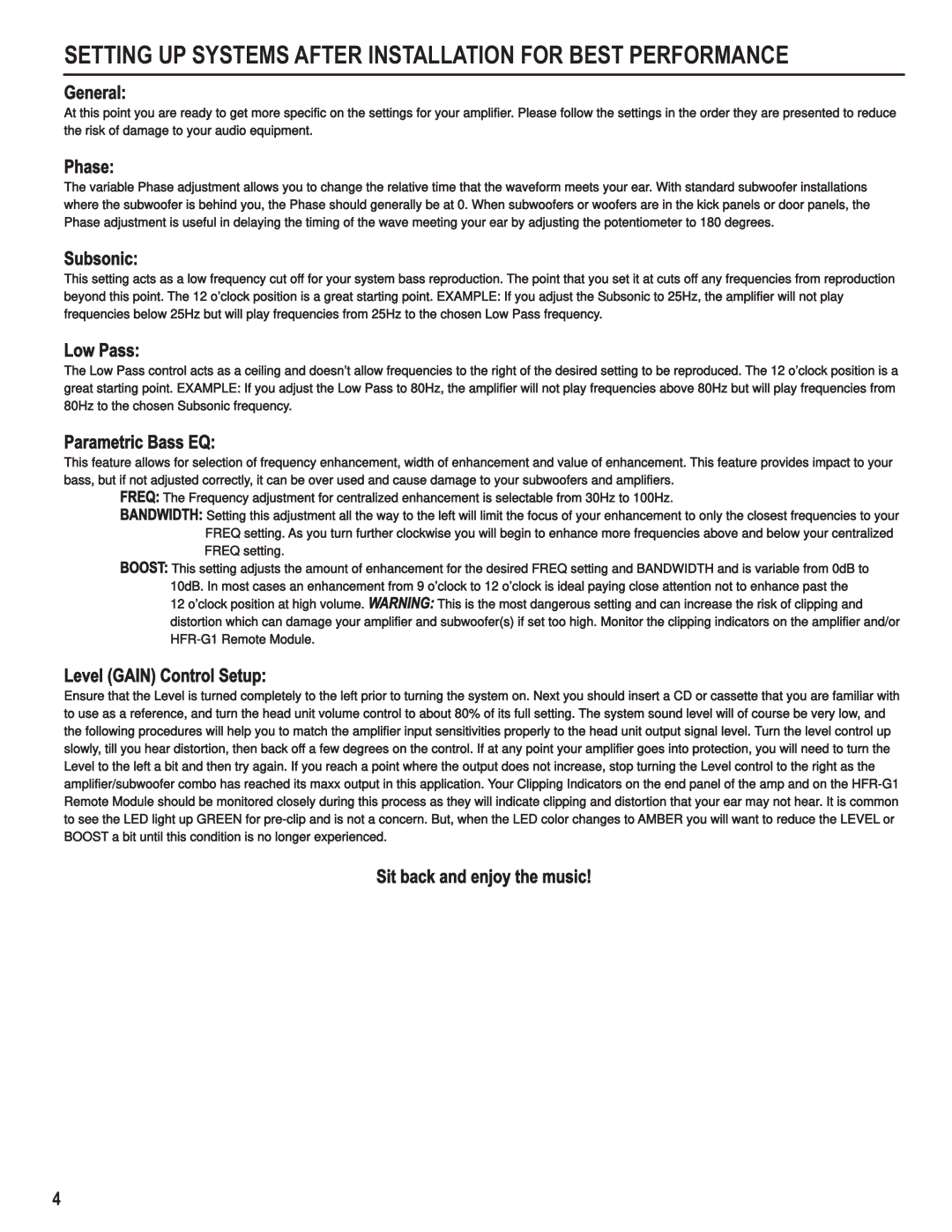SETTING UP SYSTEMS AFTER INSTALLATION FOR BEST PERFORMANCE
General:
At this point you are ready to get more specific on the settings for your amplifier. Please follow the settings in the order they are presented to reduce the risk of damage to your audio equipment.
Phase:
The variable Phase adjustment allows you to change the relative time that the waveform meets your ear. With standard subwoofer installations where the subwoofer is behind you, the Phase should generally be at 0. When subwoofers or woofers are in the kick panels or door panels, the Phase adjustment is useful in delaying the timing of the wave meeting your ear by adjusting the potentiometer to 180 degrees.
Subsonic:
This setting acts as a low frequency cut off for your system bass reproduction. The point that you set it at cuts off any frequencies from reproduction beyond this point. The 12 o’clock position is a great starting point. EXAMPLE: If you adjust the Subsonic to 25Hz, the amplifier will not play frequencies below 25Hz but will play frequencies from 25Hz to the chosen Low Pass frequency.
Low Pass:
The Low Pass control acts as a ceiling and doesn’t allow frequencies to the right of the desired setting to be reproduced. The 12 o’clock position is a great starting point. EXAMPLE: If you adjust the Low Pass to 80Hz, the amplifier will not play frequencies above 80Hz but will play frequencies from 80Hz to the chosen Subsonic frequency.
Parametric Bass EQ:
This feature allows for selection of frequency enhancement, width of enhancement and value of enhancement. This feature provides impact to your bass, but if not adjusted correctly, it can be over used and cause damage to your subwoofers and amplifiers.
FREQ: The Frequency adjustment for centralized enhancement is selectable from 30Hz to 100Hz.
BANDWIDTH: Setting this adjustment all the way to the left will limit the focus of your enhancement to only the closest frequencies to your FREQ setting. As you turn further clockwise you will begin to enhance more frequencies above and below your centralized FREQ setting.
BOOST: This setting adjusts the amount of enhancement for the desired FREQ setting and BANDWIDTH and is variable from 0dB to 10dB. In most cases an enhancement from 9 o’clock to 12 o’clock is ideal paying close attention not to enhance past the
12 o’clock position at high volume. WARNING: This is the most dangerous setting and can increase the risk of clipping and distortion which can damage your amplifier and subwoofer(s) if set too high. Monitor the clipping indicators on the amplifier and/or
Level (GAIN) Control Setup:
Ensure that the Level is turned completely to the left prior to turning the system on. Next you should insert a CD or cassette that you are familiar with to use as a reference, and turn the head unit volume control to about 80% of its full setting. The system sound level will of course be very low, and the following procedures will help you to match the amplifier input sensitivities properly to the head unit output signal level. Turn the level control up slowly, till you hear distortion, then back off a few degrees on the control. If at any point your amplifier goes into protection, you will need to turn the Level to the left a bit and then try again. If you reach a point where the output does not increase, stop turning the Level control to the right as the amplifier/subwoofer combo has reached its maxx output in this application. Your Clipping Indicators on the end panel of the amp and on the
Sit back and enjoy the music!
4
